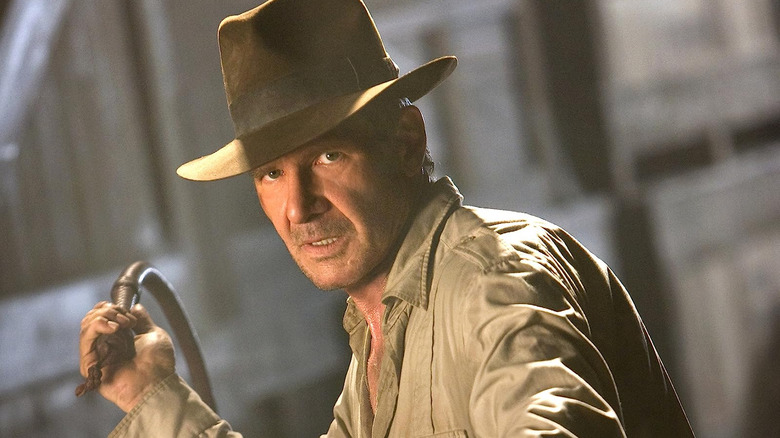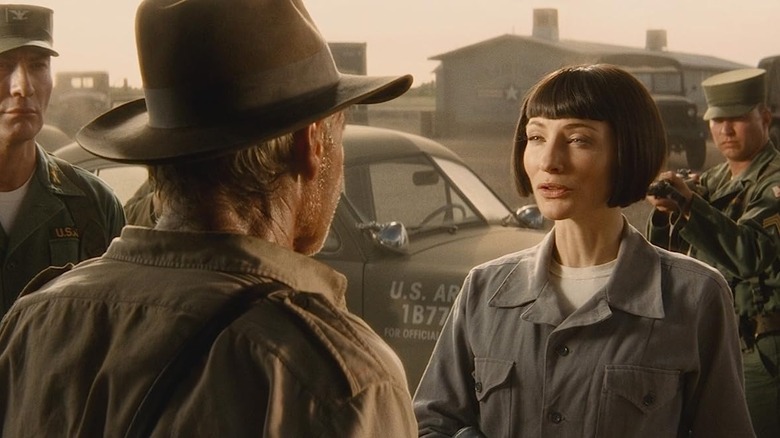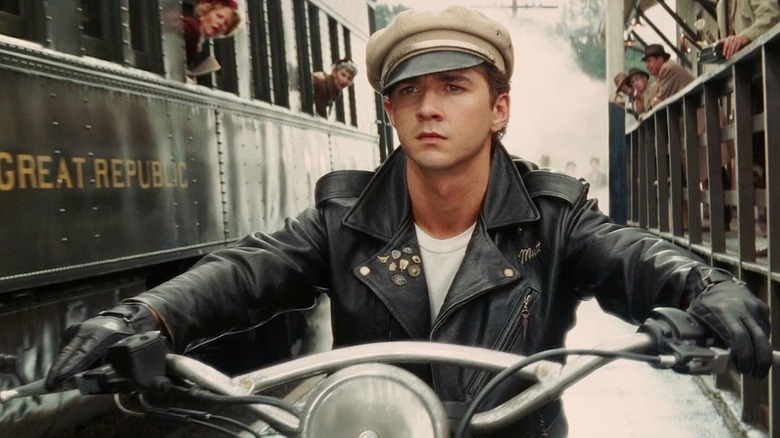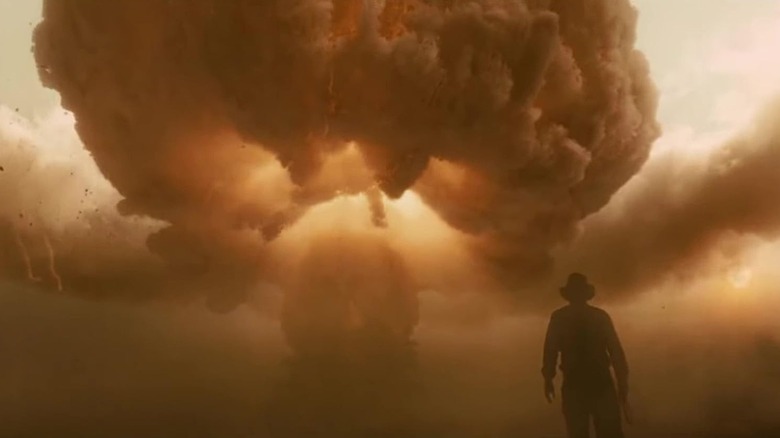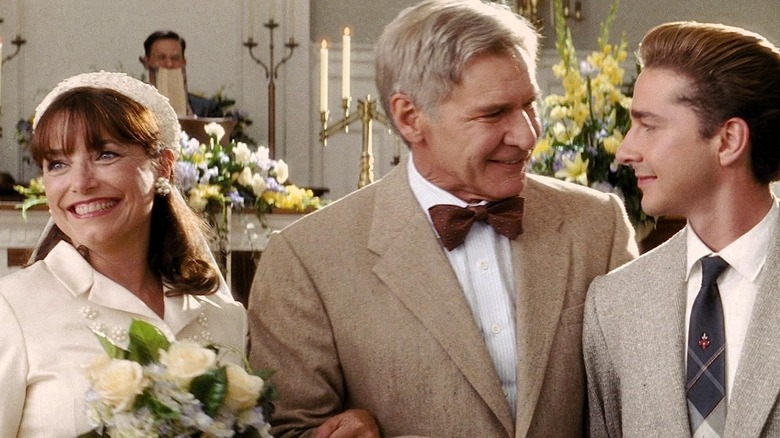Indiana Jones And The Kingdom Of The Crystal Skull Is Actually Good, So Put That In Your Fridge And Nuke It
Sitting down to watch "Indiana Jones and the Kingdom of the Crystal Skull" during its opening weekend in May 2008, it was hard to know exactly what to feel. Indy's return to the big screen after a 19-year absence was certainly cause to celebrate, but was there any way the film could live up to nearly two decades of hype? It didn't help that, just a few weeks earlier, a little movie called "Iron Man" had burst onto the scene. Already, there was a sense Harrison Ford's crusty, whip-cracking archaeologist and his adventures were about to become relics of a bygone age of action cinema. One might say they ... belonged in a museum.
Ironically, it's "Crystal Skull" that, in many ways, feels less dated than "Iron Man," looking back 15 years later. While Jon Favreau's superhero film is a politically suspect military fantasy, "Crystal Skull" grapples with questions about patriotism and the horrors of the Atomic Age. By that same token, Tony Stark's billionaire playboy has lost much of his charm, and the idea he could actually have a crisis of conscience seems almost dangerously naive in the face of real-life soulless tech magnates like Elon Musk (who even cameoed as himself during "Iron Man 2"). "Crystal Skull," on the other hand, was the first film to give us an older Indy who's shed his more toxic qualities, yet still has the sparkle of a scoundrel in his eyes.
"But wait," I can already hear you say, "what about those CGI vine-swinging monkeys? And the fridge-nuking? And Shia LaBeouf?" And so on and so forth. Time to strap yourselves in, kids. With Ford's final outing as the man in the hat, "Dial of Destiny," now playing in theaters, I'm ready to argue that "Crystal Skull" is good, actually.
Indiana Jones meets post-9/11 Spielberg
By the time they made "Crystal Skull," Indiana Jones masterminds Steven Spielberg and George Lucas were far removed from the bushy-haired whizkids who'd conquered Hollywood back in the 1970s. The former Movie Brats had developed greatly as artists since the release of 1989's "Indiana Jones and the Last Crusade." Having now faced the real-world horrors of the Holocaust in "Schindler's List," Spielberg spent the first chunk of the 2000s wrestling with his post-9/11 anxieties in films like "Minority Report" and "War of the Worlds" (two of the darkest genre films of his career). Lucas' own concerns about the encroaching resurgence of fascism in the late 20th century similarly manifested themselves in his "Star Wars" prequels, which wore their politics on their sleeve as much as — if not more than — Spielberg's work at the time.
All of this posed the question: Could these guys even have fun anymore, playing in the pulpy sandbox they'd created with "Raiders of the Lost Ark?"
"Crystal Skull" absolutely reflects Lucas and Spielberg's newfound outlooks. The film's violence is more subdued than that in previous Indy films, and the franchise's trademark gruesome villain deaths are less gleeful here than the face-melting, rapidly aging demises before them. There's also a distinctly post-9/11 sense of distrust in both the U.S. government and figures of authority that permeates the film. Moreover, there's no overlooking the ways "Crystal Skull" highlights the parallels between the post-WWII Red Scare/'50s McCarthyism and the political atmosphere of the '00s early on when Indy is forced into taking an indefinite "sabbatical" from his professorship after the FBI suspects him of Communist ties. Even the film's Soviet villains possesses a nuance that the Nazis and Nazi collaborators from prior Indy films neither had nor needed (Elsa from "Last Crusade" aside).
Get that greaser!
Far from an issue, these elements are some of the best parts of "Crystal Skull," as is Indy's evolution as a character. When we catch up with him in the film, Harrison Ford's gruff adventurer has matured with the franchise around him. He still packs a Foley-enhanced punch, yet he's gained a sense of humility and sensitivity after losing people close to him to the passage of time. What's more, Indy seems to actually enjoy being a teacher nowadays. This makes him the perfect candidate to mentor Shia LaBeouf's Mutt Williams, even before learning the impetuous, motorcycle-riding greaser is his son for real.
Mutt himself is essentially a himbo with a low Charisma score, but that's entirely by design. There's never any doubt we're meant to be on Indy's side as he chuckles at Mutt for being too big for his britches or scolds him for charging recklessly into danger, time and time again. Fun as it is to imagine a version of "Crystal Skull" that instead pairs Indy with, say, a now-grown Short Round, characters generally benefit from having arcs and Indy has far more to teach someone like Mutt (and to learn about himself in the process) than he ever would his "Temple of Doom" sidekick. That their dynamic deliberately parallels Indy's relationship with his own father in "Last Crusade" also lends "Crystal Skull" a richer thematic connection to the "Indiana Jones" films before it.
You can, in turn, see how this makes "Crystal Skull" a personal film for Steven Spielberg in ways that "Temple of Doom" never was. It speaks to both the filmmaker's continuing examination of fatherhood in his work — that and his personal experiences becoming a parent and mending his relationship with his real-life father — as much as his political concerns.
Anyway, so about that fridge...
It's funny to think "Crystal Skull" was once criticized for going overboard on CGI. The film is loaded with great-looking practical set pieces and sequences, ranging from the opening tussle in Hanger 51 and the "Greasers vs. Jocks" brawl to Indy and Mutt's merry chase with Soviet agents around the Marshall College campus and their subsequent tomb-raiding in Peru and the mystical city of Akator. Of course, with Steven Spielberg behind the camera, both the action beats and dialogue-heavy scenes are filled with clear, pleasant compositions, many of which are realized through the fluid camerawork of classic Spielberg Oners. And what "Indiana Jones" film would be complete without a rousing John Williams score — in this case, one that takes its cues from the same period-appropriate '50s sci-fi B-movie influences as the plot.
This brings us at last to that dagnabbit fridge scene. The inherent creepiness of the model town at the nuclear testing site Indy stumbles onto in "Crystal Skull" honors those aforementioned '50s sci-fi inspirations by illuminating the darker side of the decade, as does the visual of Indy surveying an awe-inducing yet horrifying mushroom cloud after escaping the now-incinerated site by the skin of his teeth. That he did so by taking shelter in a lead-lined refrigerator — one that's sent bouncing across the surrounding desert in a move that feels lifted directly from Wile E. Coyote's playbook — is the part that people understandably get hung up on. If there's a line for just how cartoony the "Indiana Jones" films are allowed to be, this scene apparently stomped on it multiple times with both feet.
Funnily enough, the "Nuke the Fridge" scene does, in fact, embody the main problem with "Crystal Skull" — just not necessarily in the way a lot of people think.
It's not always easy getting older
In its weaker moments, "Crystal Skull" feels like the result of Steven Spielberg, George Lucas, and their collaborators — not least of all credited writers David Koepp and Jeff Nathanson — trying to go backward. Moments like Mutt suddenly becoming George of the Jungle and getting smacked in the crotch by plants mid-jungle chase (or Indy getting caught in quicksand and having to use a — you guessed it — snake to get out) come off feeling like strained attempts at silliness because, well, they are. "Crystal Skull" is better off when it accepts that Indy and his adventures can still be fun, just not in the way they used to be ... or to put it another way, when the film embraces its age.
Honestly, "Crystal Skull" works perfectly well when it does this, like when Indy's reunion with Marion (Karen Allen) takes the spotlight (should've been the whole movie, though!) or it reveals that Cate Blanchett's diabolical Irina Spalko intends to use the crystal skulls to insidiously brain-wash people without them knowing it — a timely update from the fascists in the earlier "Indiana Jones" films, who were more focused on amassing wealth and power through mystical artifacts. That goes double for the moments where it addresses Indy's age without resorting to tedious "Old Man Indy" gags. Getting older can be tricky for anyone, much less for a throwback action-adventure franchise renowned for its rollicking pacing and pulpy vibe. But "Crystal Skull" doesn't get the credit it deserves for handling this task as capably as it does.
"Indiana Jones and the Dial of Destiny" is currently in theaters. "Kingdom of the Crystal Skull" and the other "Indiana Jones" films are available for streaming on Disney+.
